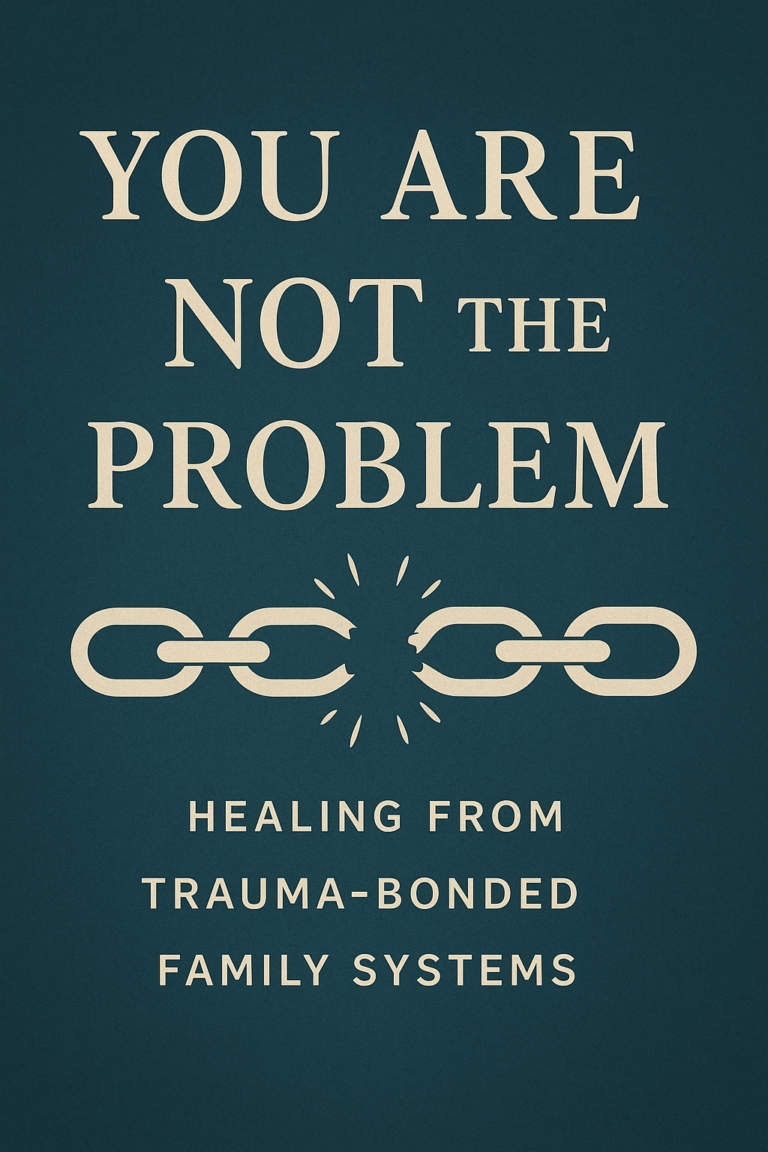If you’ve been scapegoated for leaving an abusive or toxic partner or family system, you are not the problem. Learn how narcissistic abuse operates within trauma-bonded families and how to reclaim your voice and peace.
Silence Isn’t Peace, It’s Suppression
In families where emotional dysfunction runs deep, silence is often mistaken for peace. These systems are not built for openness or honesty, they’re built for emotional survival for the abuser and themselves. This mentality usually comes at the expense of reality, truth, autonomy, and mental health.
The moment one member begins to set boundaries, tell the truth, or break the unspoken rules, the system doesn’t adapt. It resists. And often, it retaliates.
If you’ve ever been targeted, minimized, or ostracized for choosing healing over compliance, you are not alone, and you are not wrong. This is not personal. It’s a structural dysfunction reacting to disruption.
What Is a Trauma-Bonded Family System?
A trauma-bonded family system is one where dysfunction is normalized, and survival patterns are passed down through generations. These families often revolve around a central figure (or multiple figures) who exhibit narcissistic traits: controlling others, rewriting reality, and punishing those who resist, get in the way, or don’t give them what they want.
These systems don’t just fail to protect victims of abuse; they protect the abuser and punish the truth-teller.
Here are four traits common to narcissistic family systems:
Enmeshment: You Are Not Allowed To Be You
In enmeshed families, individuality is seen as betrayal. You’re expected to align with the family’s emotional tone, beliefs, and behaviors, even when those are harmful.
If you make a different choice, speak up, or set a boundary, you’re labeled as difficult, unstable, or disloyal.
That translation is simple: you’re not allowed to grow, only to conform.
Scapegoating: You Became The Target When You Left
Scapegoating occurs when the family needs a target to project its unacknowledged pain and shame. If you stand up, leave, or protect your children, the dysfunction no longer has a container, so they pour it into you.
You are not broken. You are just no longer willing to carry the emotional burden they refused to face.
Collective Gaslighting: The Truth Becomes The Threat
Gaslighting doesn’t always come from one person. In a narcissistic family system, it can come from the entire group. You may hear things like:
- “It wasn’t that bad.”
- “Just let it go, no reason to dwell on it.”
- “You’re overreacting.”
- “You’re making a big deal out of nothing.”
But what’s happening is a coordinated effort to protect the family’s illusion of normalcy. You threaten that illusion simply by telling the truth.
They’re not defending reality. They’re defending denial. They’ve been desensitized to abusive and toxic behavior because it’s so common within their dynamic and “How it’s always been.”
Abuse Survival as Identity: Pain Becomes Loyalty & Virtue
Many of the people who minimize or excuse abuse were once victims themselves. But instead of healing, they internalize suffering as a badge of honor.
In their worldview, enduring pain equates to loyalty. So when you break free, you force them to confront that they never did. And instead of following your lead, they may try to pull you back into silence.
To these families, I would challenge them to answer these questions to themselves:
- Have I ever protected someone in my family because the truth would make me uncomfortable?
- Have I ever prioritized my family’s image over someone’s pain?
- Have I ever known of abuse and looked the other way while convincing myself it wasn’t that bad?
These things are not love. They are learned dysfunction.
Sometimes people closest to the abuser will feign impartiality, but when dealing with abuse/abuser, there can be no neutrality. There’s only acknowledging or enabling. Neutrality in the face of abuse (to the family) is complicity in reality. And enablers, more often than not, are not evil; they have built their own identity around survival and silence. You can’t expect them to show up for you, someone outside the family, when they wouldn’t even take a stand for themselves if it meant shedding light on family “laundry”.
The Psychological Toll: You May Be Living With C-PTSD
If you’ve lived through this, especially when it’s reinforced by an abuser’s family, you may have developed complex PTSD (C-PTSD).
This is not “being sensitive.” This is a clinically recognized trauma response to long-term relational abuse.
Symptoms of C-PTSD include:
- Chronic self-doubt
- Emotional flashbacks
- Hypervigilance
- Identity confusion
- Brain fog and exhaustion
- Difficulty trusting others
Healing takes time, but it’s possible. A trauma-informed therapist can help you untangle years of gaslighting, betrayal, and emotional suppression.
What You Are Not Responsible For
You are not responsible for:
- The discomfort of others when you tell the truth
- Their refusal to acknowledge reality
- Their projection of shame or guilt
- Maintaining their illusion of normalcy
- “Keeping the peace” by staying silent
You didn’t cause the system, you inherited it by proximity. And walking away does not make you cruel, it makes you conscious.
What You Are Allowed To Do
You have full permission to:
- Name what happened
- Protect your children
- Heal out loud
- Set firm, unapologetic boundaries
- Say no
- Never look back
Speaking up isn’t vindictive. It’s self-preservation. And yes, it will make people uncomfortable.
Final Thoughts: Breaking The Cycle Is The Revolution
Your strength may feel threatening to those who benefited from your silence. But it could be life-saving for you and your children.
This is not overdramatic. I want to dive a little deeper into something here: When I used to hear people talking about how abuse escalates, or the statistics about how many women are killed by intimate partners, I’ll admit, I thought it sounded dramatic. I didn’t take it seriously. Not because I didn’t care, but because I couldn’t imagine myself in that kind of danger. And that’s exactly how abuse hides: it convinces you that what’s happening isn’t that bad, that you’re overreacting, and that you’re safe… Until you’re not.
According to the CDC, more than half of female homicide victims in the US are killed by a current or former male intimate partner.
You are not “too much.” or “the problem.” You are the disruption in their chaos, you’re saying, “This is not right”. And you become the enemy for shining a light on what they want to remain unspoken. “Oh, that’s just how he is.” “He’ll calm down and snap out of it.” “That’s just how he gets when he’s mad.” Becomes their excuses that they view as explanations. These are thin layers of attempted justification or normalization to keep the abuse silent and the abuser unaccountable. They don’t want peace, they want compliance so they don’t have to do the hard work of confronting inappropriate behavior that they may even view as perhaps partially their fault, which would ultimately mean they would have to look in the mirror.
You’re the cycle breaker.
And that is not just brave.
It’s heroic.
Click if you need HELP NOW or call the National Domestic Violence Hotline at 1-800-799-7233 or text BEGIN to 88788
For Native Americans and Alaska natives affected by domestic and sexual violence, call StrongHearts Native Helpline at 1-844-762-8483 or go to www.strongheartshelpline.org
RAINN (Rape, Abuse, & Incest National Network) is 1-800-656-HOPE (4673) or go to their website at www.rainn.org



